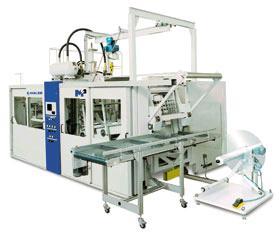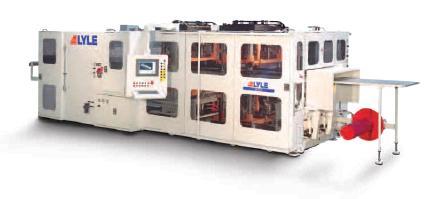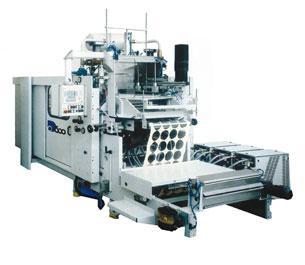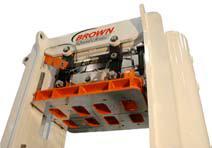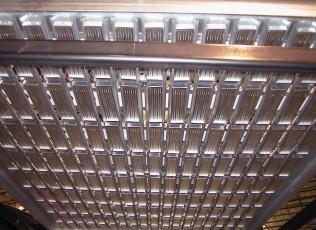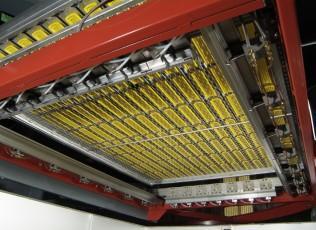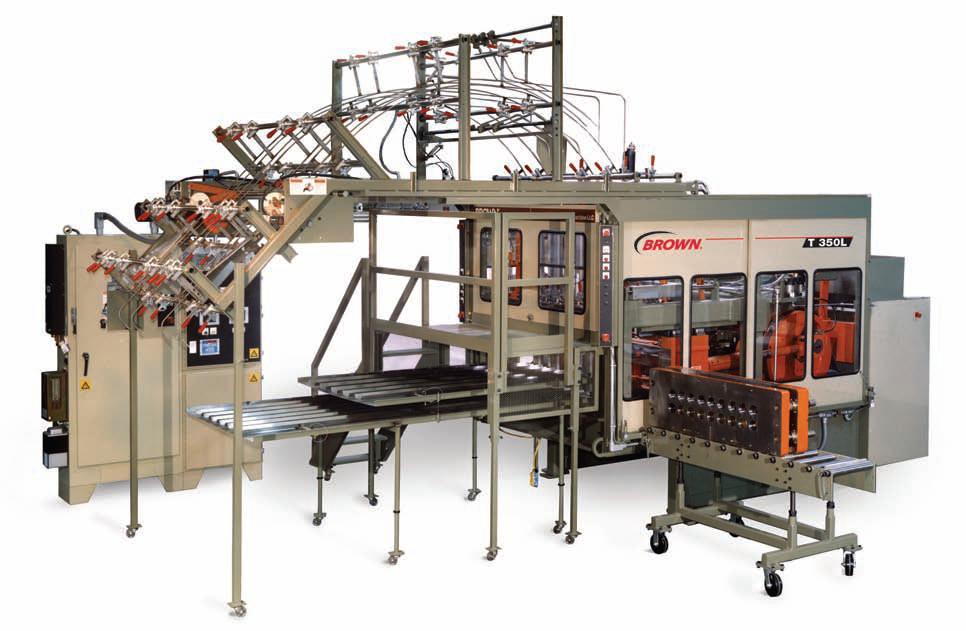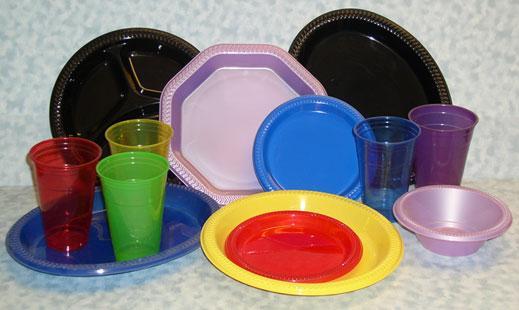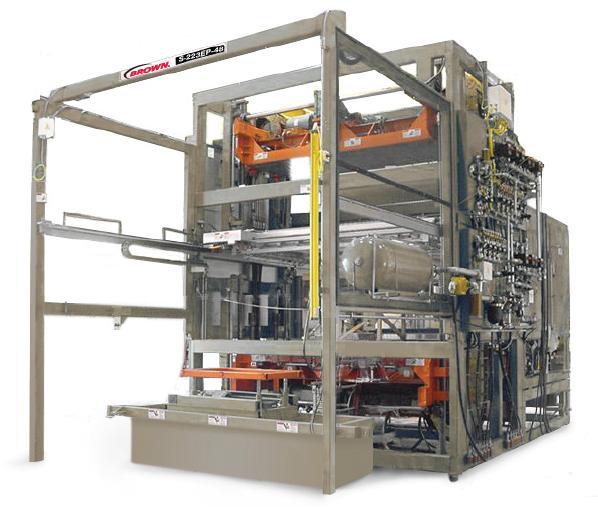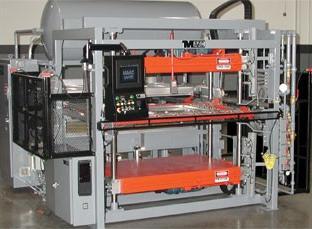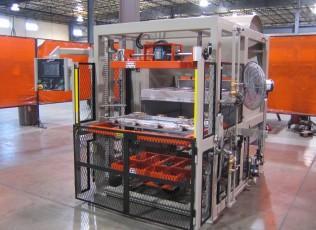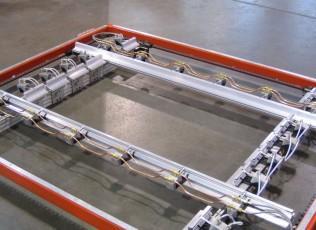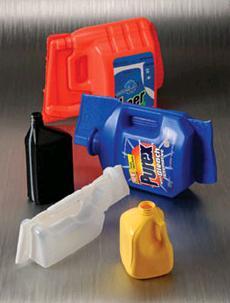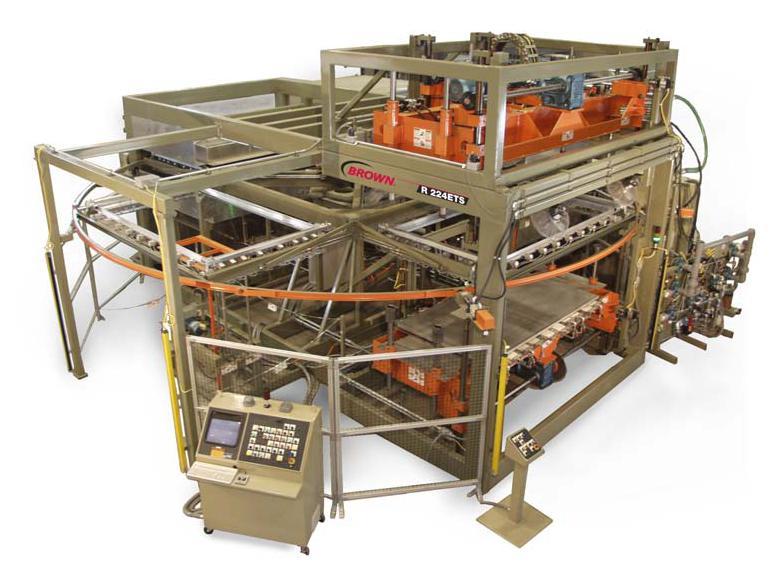Thermoforming involves heating a sheet of thermosetting plastic material until it softens, then molding it into a desired shape.
Polymer Product Manufacturing Steps
Thermoforming is one of the ways you can process the polymer in the manufacture of polymer products:
In-Line
In-line, or roll-fed, thermoformers mold hot sheets of plastic directly from an extruder , and incorporate secondary processes to increase efficiency.
General Information
In-line thermoformers take their name from being placed “in-line” with an extruder and other secondary operations. This allows the process to use the already hot plastic sheets leaving the extruder, reducing the amount of heating required in the thermoformer.
In-line thermoformers are used to produce thin-walled products with a maximum thickness of 12 millimeters. In-line thermoformers are extremely fast in comparison to other molding processes, but do not yield close tolerances .
Equipment Design
The thermoforming process starts with a sheet of hot plastic material being fed into the thermoformer from a roll station , then passed through an oven . Once it is at the right temperature, the sheet passes into the forming station , such as the one pictured below, which molds the material. The formed parts then cool and are sent to a trim press .
Molding in thermoforming can occur in three ways, mechanical forming , vacuum forming , and pressure forming . While all three are common, vacuum forming is the most popular.
Ovens heat the plastic sheets to a temperature at which they become pliable but do not melt. Ovens come in many types, the most common being tubular , quartz (pictured left), and ceramic (right).
(Courtesy of MAAC Machinery Corporation, Carol Stream, IL)
For large sheets and materials that sag when heated, lower ovens in newer machines can move to keep an equal distance from the sheet, as opposed to having the lower oven set several inches below the sheet. Moving ovens can be set at much lower temperatures and use less energy to heat the material. For thin materials or materials that cool quickly, some machines have the top oven move with the product to the form station to help retain heat.
After being molded, the sheet of plastic products is sent to a trim press to have the excess plastic trimmed off, separating the products.
Usage Examples
A few examples of in-line thermoformed products can be seen below. In-line thermoformers are used to produce objects with thin walls such as cups, lids and plates. The speed and ability to include secondary processes makes in-line thermoforming the most economical production process for many industries that do not require close tolerances.
Advantages
- High-speed.
- Secondary operations may be added easily.
- Sheets are already hot from extruder, saving energy.
Disadvantages
- Cannot produce products with close tolerances.
- Difficult to control uniformity of moldings.
- Problems in one operation require the shut-down of the whole process.
Shuttle
Shuttle thermoformers are the most basic of the thermoforming machines. They may be manipulated and adjusted as needed, making them all-purpose thermoformers.
General Information
Shuttle thermoformers are simple and provide the most flexibility in production. The term “shuttle” refers to the shuttling of the plastic sheets in and out of the thermoformer.
Shuttle thermoformers can be manipulated to produce a large variety of products using different production rates. They can be controlled manually, automatically, or semi-automatically.
Equipment Design
The picture below shows a typical single station thermoformer. Important components of the thermoformer include: the clamping frame, which holds the plastic sheet in place, mold plates containing the mold, an oven to heat the plastic sheet prior to molding, and a control panel.
Most clamp frames must hold at least half an inch of material. The clamp frame shown on the right requires only 3/8″ of material to be held and can be easily adjusted with minimal changeover time.
(Courtesy of MAAC Machinery Corporation, Carol Stream, IL)
Newer machines are controlled with flat-panel touch screen interfaces. The current innovative software gives thermoformers the ability to monitor and change every parameter within seconds. There are also built-in alarms and warnings to alert the operator of potential human error.
Molding in a shuttle thermoformer occurs in the same ways as in in-line thermoforming, using pressure, vacuum, or mechanical molding techniques.
Usage Examples
The adjustability of shuttle thermoformers makes them popular as test equipment in research and development. Shuttle thermoformers are used to make products such as the orange juice and detergent bottles pictured here. The bottles in the back show what the thermoformed products looked like prior to trimming.
Advantages
- Can be easily modified to fit needs.
- Simple equipment.
- Can be operated manually, automatically, or semi-automatically.
- Equipment can be modified to reproduce results from other thermoformers.
Disadvantages
- Slower than in-line thermoformers.
- Secondary operations cannot be attached.
- Conditions must be precisely controlled to ensure consistency in moldings.
Rotary
General Information
Rotary thermoforming separates the steps of a shuttle thermoformer into a series of stations to increase the production speed.
As shown in this animation, rotary thermoformers typically contain three or four stations that constitute a complete thermoforming cycle. The processes included in each station perform a specific function and can vary in type from machine to machine. Rotary thermoformers allow multiple sheets of plastic to undergo different steps in the thermoforming process simultaneously.
Equipment Design
All rotary thermoformers consist of a loading and unloading station, an oven, and a mold. A plastic sheet is loaded on to a rotating frame and held by clamps. The sheet is rotated into the oven, where it is heated to the processing temperature. Once heated, the plastic sheet is molded by vacuum, by pressure, or mechanically, and then cooled in the forming station and unloaded as a product.
Variations to the standard three-station rotary thermoformers contain two ovens, one to pre-heat and one to final heat, additional molds to aid in shaping the plastic, or a trim station.
Usage Examples
Many plastic items are produced by rotary thermoforming. The same products that can be produced by in-line and shuttle thermoforming can be made using rotary thermoforming.
Advantages
- Faster than shuttle thermoforming.
- Allows good production flow.
Disadvantages
- Delays in one stage can seriously affect other stages.
- Stages must be synchronized.
- Drafty plant condition can cause heat loss and poor molding while rotating between stations.
Acknowledgements
- BROWN Machine LLC, Beaverton, MI; now part of BMG Solutions
- LAMCO Machine Tool, Inc. , Morehead City, NC
- Lyle Industries, Inc., Beaverton, MI; now part of BMG Solutions
- MAAC Machinery Corporation , Carol Stream, IL
References
- Alongi, Michael P. “Advances in Thermofoming Machinery.” Plastics Distributor & Fabricator 7 July 2007. Web. 23 Aug. 2011.
- Chanda, Manas and Salil K. Roy. Plastics Technology Handbook . New York: Marcel Dekker, Inc., 1998. Print.
- Florian, John. Practical Thermoforming: Principles and Applications . New York: Marcel Dekker, Inc., 1996. Print.
- Rosen, Stephen L. Fundamental Principles of Polymeric Materials . New York: John Wiley & Sons, 1982. Print.
Developers
- Daniel Viaches
- Steve Wesorick
- Kelsey Kaplan

